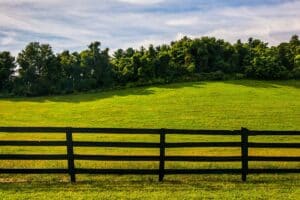Among the countless problems that can occur during the “sale pending” period of a land transaction, a survey is at the top of the list. Along with title issues, survey problems adversely impact more land closings than anything else. In this article, we will explain surveys and their significance to landowners, particularly those making preparations to sell. Let’s start with a little insight into the practice of land surveying from a historical perspective and then compare that with modern methods utilized today.
Surveying is the art and science of making measurements to locate points on, above or beneath the earth’s surface. The surveyor cannot by his own actions establish new boundary lines. However, he can use his experience and knowledge to formulate an opinion concerning the location of a boundary line in question. The actual survey is the measure of an area, calculated in acres in the U.S. One acre is 43,560 square feet. Why such an odd number? Acres are based on “chains” or rather 66 ft. increments. An acre is exactly 66 feet x 660 feet or 1 chain x 10 chains. Another measurement based on chains is the mile which is 5,280 feet or 80 chains. A more common way to envision a one acre area is that it covers approximately 208ft. X 208 ft. A typical subdivision lot of 100′ of frontage x 200 feet of depth is about 46 hundredths of an acre.
There are two types of surveying methods, the “Rectangular Survey” and the “Metes and Bounds.” The Rectangular version is based on sections and townships and is common in the western portion of the country. That’s why when you fly over western states; the ground resembles a patch work quilt. The “Metes and Bounds” survey is generally used throughout the eastern part of the country and describes the boundaries of a tract in distances and directions.
For many years surveyors employed the use of tapes and/or Günter’s chains in order to determine the distances between points, while the “Transit”, a compass type instrument determined direction. Since the mid 1980’s computerized laser transits have become protocol for the surveying industry. By using a laser beam, distances may be calculated to within thousandths of an inch and directions are plotted using computerized instruments with digital read-outs. New technology is amazingly accurate and dependable, although different surveyors still reach different conclusions. We will get into this more a bit later.
When a surveyor performs a boundary survey as opposed to a division survey he is simply following the metes and bounds that were previously established. He studies the old deeds and plats, then determines to the best of his ability where the line should start, the direction it should run and what the distance should measure. Hopefully, guidance is offered by old, established landmarks and monuments. While any two professional surveyors often come up with small amounts of variation in the same lines, some surveyors are much more skilled at the trade. Additionally various classes of surveys allow for a larger margin for error. Even minor variations can cause significant discrepancies. Consider that with a rectangular 15 acre parcel (1500 ft. x 435 ft), an error of 1 degree in either of the 1500 ft. lines represents about 1/3 of an acre. At $10,000.00 per acre this amount of discrepancy will pay for several surveys in our market area.
In addition to re-establishing where the lines should be and the quantity of acres, an all-inclusive boundary survey will show road frontage, rights-of-way, easements, monuments, structures, encroachments, rivers, creeks, ponds, wells, cemeteries and other established landmarks. The more extra’s you want “spotted” as surveyors say, the more it will cost you. However, presenting a recently prepared and all-inclusive plat to a prospective buyer will remove a major obstacle from his or her decision making process.
All too often survey discrepancies are revealed after the contract is signed and a buyer is involved. It can be a deal breaker when the final survey plat deviates from what was initially represented. Depending on the amount of deviation, a material fact is deemed to have been discovered. Such discovery gives the purchaser an option to either walk away from the sale and receive a refund of the deposit or renegotiate the contract.
Its far better to know exactly what you are offering to sell before you try to sell it. As an example let’s say your deed and old plat indicates 10 acres. You and the neighboring landowner agree that he will purchase the land for $100,000.00. The contracts are signed and you are moving toward closing when a new survey reveals there are only 9.25 acres. There is no chance your friendly neighbor would then agree to just go ahead and give you the $100,000.00. To the contrary, he will want to knock off $7,500.00 for the missing 3/4 acre. On the other hand if he had been given a recent plat for 9.25 acres for which you would agree to sell him for $100,000.00, he would probably have agreed to pay it. It’s human nature to resist giving up anything after you have bargained for it. Now what would happen if in the previous situation the new survey instead had shown 10.75 acres in the tract? If you guess he will want you to just give him the extra land move on up to the head of the real estate class.
It is far better to sell land by the acre and subject to a survey. In the preceding case the contract would call for “10 acres more or less with the final sales price to be determined by the survey of a Registered Land Surveyor and a final adjustment made at the rate of $10,000.00 per acre or portion thereof”. Most knowledgeable land brokers encourage their buyers to structure purchase offers in this manner and negotiate who pays for the survey. However, due to limited finances, some buyers will want to put a cap on the number of acres they are able to purchase, thus creating a problem should the survey comes in too high.
If you are determined to sell your land as a “site,” contract language can be written to make such a “site sale” binding, up to a point anyway. This is the method used by many timber companies when selling land with merchantable timber value. However, many astute buyers will not take a chance on paying for land that may not be there. Timber companies can afford to let these buyers go, but most other landowners would be better served by negotiating a bit. I remember a site sale several years back where the buyer decided to have a survey done anyway. When it came back about 5 acres low he backed out of the deal and demanded a refund of his deposit. After more than a year of posturing, the sellers released the deposit back to him. The contract was explicit, but he argued that 5 acres was a material fact and he was willing to let a judge decide. It’s better to survey before you sell and avoid the problems.
Many timber companies also sell their tracts using timber type maps that indicate acres derived from GPS measurements. We have been involved with thousands of acres sold by this method and offhand I can’t remember a single tract that was subsequently surveyed and the amount of acreage came in higher. There is always a shortage, I suppose, because the instruments are less accurate and the individuals doing the measuring walk around the outside of the tract.
Large deviations are not unheard of. A tract we bought around 1990 called for 200 acres, but when we had a new survey it revealed an additional 93 acres. However, most new surveys will come in low due to improved laser technology and more liability placed on surveyors in our present litigious society. It’s safer for a surveyor to accept what the adjoining landowner thinks he owns rather than risk a lawsuit by trying to claim what might rightfully belong to the other side of the line. Another major factor is Laser transits that shoot a direct line, often from the front to the back corners, as opposed to 66 foot chains that were pulled over uneven terrain. It’s reasonable to assume that if the old plat calls for 225 acres, a new survey may indicate only 220. Other variations may be due to gradual and imperceptible changes brought about due to streams or rivers naturally changing course.
Road frontage and/or road access are important factors to consider when buying land. A new survey will accurately indicate road frontage variations, particularly those that may have occurred due to a road having been shifted over the years. . We recently discovered that one of our small farm subdivisions did not touch the county road. Fortunately we were able to buy the separating strip and move ahead, but the price was steep. In Spartanburg County most county road easements run ditch to ditch. If your land doesn’t adjoin the ditch, you are effectively precluded from accessing the road until negotiating an agreement with the adjoining landowner.
State roads around here generally have a 66 foot right-of-way. If you are in the right-of-way, you can usually obtain an encroachment permit to connect, assuming you have line of sight visibility and sufficient frontage to meet county regulations. State roads require 100 feet of unobstructed visibility for each 10 mph of speed limit. Visibility is a major issue as regulators are very reluctant to issue variances that could come back on them in the event of an accident. It’s better to know about the problem before you sell and once again your surveyor can help.
Hopefully some of this information will prove useful to those of you making preparations to market your land. If you have further questions, comments or need a good local surveyor, send us an e-mail and we will attempt to assist.
—————-
The Metcalf Land Company, Inc. was founded January 1971 in Spartanburg, South Carolina. We are a small family-owned company specializing in the sale of acreage, farms, timberlands and recreational properties in Upstate South Carolina and Western North Carolina. Visit our website at www.metcalfland.com.
This content may not be used or reproduced in any manner whatsoever, in part or in whole, without written permission of LANDTHINK. Use of this content without permission is a violation of federal copyright law. The articles, posts, comments, opinions and information provided by LANDTHINK are for informational and research purposes only and DOES NOT substitute or coincide with the advice of an attorney, accountant, real estate broker or any other licensed real estate professional. LANDTHINK strongly advises visitors and readers to seek their own professional guidance and advice related to buying, investing in or selling real estate.









Thanks for the interesting read about surveys and some of their benefits. I’m glad that you mentioned your story about the person who got a survey and the results came back 5 acres low. After reading that, I can definitely understand the importance of getting a survey. It seems like a great way to get an accurate size estimate, so that possible buyers know exactly the amount they will be getting. Not only that, but it sounds like the seller and the buyer benefits from a survey like this.
My wife and I are wanting to buy some property to build on soon, so we are looking into having the land surveyed. I had no idea that lasers were used to calculate the distances within thousands of an inch. This seems really useful for property disputes or just making quick measurements. Thanks for sharing.
It’s helpful to know that if you wait until a buyer is involved to get a land survey that any issues it discovers could damage the deal. I was recently offered a new job across the country, so we’re thinking of moving pretty soon. Getting a land survey taken care of quickly might help us avoid complications during the rest of the selling process.